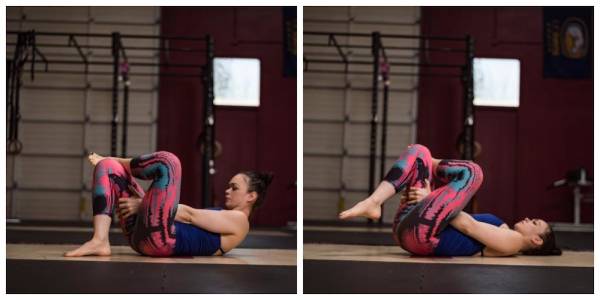A good 90% of my clients (both for massage therapy and training) complain of some sort of pain regularly. In fact, it’s often the reason they seek me out in the first place. For the general population, nagging perpetual pain in the upper back, shoulders, and knees is egregiously common.
A good 90% of my clients (both for massage therapy and training) complain of some sort of pain regularly. In fact, it’s often the reason they seek me out in the first place. For the general population, nagging perpetual pain in the upper back, shoulders, and knees is egregiously common.
For athletes or generally active people, minor or severe pain or injury in and around the joints is a regular (and often self-induced) occurrence. In my experience, many of these issues arise from three main shortcomings:
- Ignorance
- Laziness
- Ego
While many injuries and chronic issues do require medical intervention (as an aside – I am not a medical professional and I cannot diagnose, treat, nor prescribe), many of these inconvenient aches and pains can be avoided—or at least greatly attenuated.
If you are an athlete (or if you just work out a lot), you probably already know this. You may even do a little bit of mobility here and there. Maybe it helps, maybe it doesn’t. Let’s talk about why and the how.
The Big 3
There has been a big push for more mobility in the fitness communities in the past eight years or so. This is great. Having the mobility to move our joints through full ranges of motion is important.
Additionally, having the stability to keep ourselves from moving past a healthy range of motion is just as important. Having the body awareness to know which muscles we are activating and stretching, and when pain is or isn’t a serious warning sign, is even more important.
In many fitness programs, one, two, or all three of these elements get ignored. The mobility revolution has been fantastic for many reasons, but often results in the neglect of stability and kinesthetic awareness.
Self-care and maintenance—while many in the fitness communities brush it off as weak or “soft”—is crucial to our health and wellness. It’s not rocket science, but it can most definitely be boring.
And it’s not sexy. These days hitting a new PR in our squat, or running our fastest mile, or doing 50+ pull ups is considered sexy. Static stretching, foam rolling, band exercises, and isometric holds are not sexy.
You know what’s even less sexy? Not being able to get out of bed in the morning without pain while your body sounds like a giant bowl of Rice Krispies. Or maybe aggravating your shoulder to the point that you can’t fasten your own seatbelt for a week.
Whether you are an athlete or an office worker, preventative maintenance on your body is a big deal. Acquiring the knowledge and budgeting the time to properly perform this body maintenance is also a big deal and can be a huge obstacle for many of us, so let’s talk about “the how.”
When it comes to working on “the big 3″—technically, you don’t really need anything, but it can be helpful to have some tools at your disposal. I recommend getting a couple of Therabands, a lacrosse ball or two, and a foam roller.
If you don’t have any of these tools, you can still do a whole lot. In other words: no excuses. I could write an entire book on this, and I’ll give a sample routine at the end of this article, but let’s talk about the bare bones basics.
- Mobility: When it comes to mobility (increasing your range of motion), there are two main components: soft-tissue manipulation like foam rolling and lacrosse ball triggerpointing and good old fashioned stretching.
- Stability: Stability exercises can come in a few different forms, but my favorite stability tools are Theraband exercises, isometric holds (like planks), and unilateral exercises.
- Body Awareness: Kinesthetic awareness is much more complex. Many of us go into autopilot mode when we move and building kinesthetic awareness forces us out of that mode. Think about what muscles you are activating when you move; are you bracing through your core? When you drive through your heels can you feel your glutes and hamstrings engage? When you hold in a plank are you activating your leg muscles and pulling your shoulder blades down your back? This attention to detail becomes increasingly important as we age and especially important if we are injured or suffer from chronic nagging pain. It takes work—and it takes diligence. Don’t be lazy, this is your body. Pay attention.
As a general rule, I try to mix one “bracing” exercise, two stability exercises, and two mobility exercises into my routine 2-3 times per week. That’s it. It takes 10 minutes (I usually work it into my warm up), and I’m good to go.
Not sure where to start? Here are some examples.
Get In Touch with Your Joints and Muscles: 1. Bracing
Take 2-3 minutes to work on bracing your core and stabilizing your low back with pelvic tilts.
I follow a 3-4 step bracing sequence:
- Breathe (inhale and exhale)
- Pull belly button back toward spine (engage the abdominal muscles)
- Neutralize spine (ensure there is no over-arching or over-rounding)
- Squeeze glutes
- Slowly release and repeat
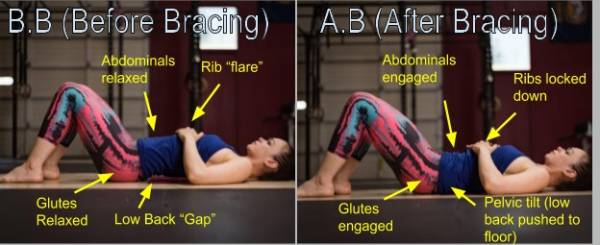
Get In Touch with Your Joints and Muscles: 2. Upper Body Stability
- 1:00 – Scapular push ups
Start in a high plank position. Begin with your bracing sequence with a neutral spine, then, without bending your elbows, squeeze your shoulder blades toward one another, and then push them apart. Every part of this movement should be deliberate and controlled.
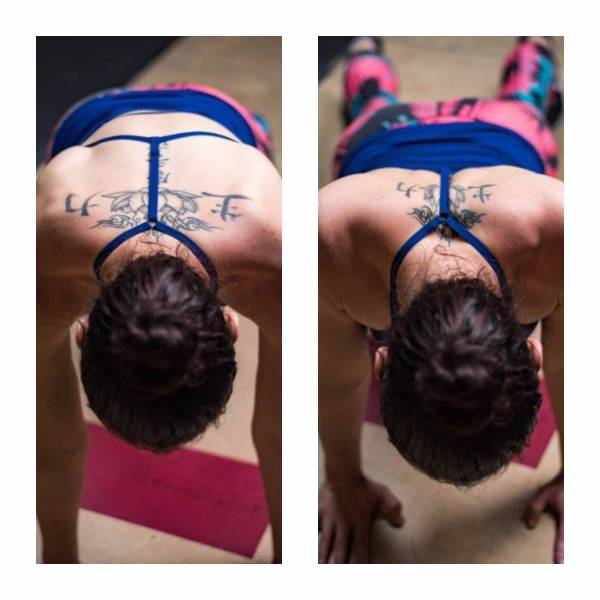
- 1:00 – Pull aparts
Pull aparts can be done with whatever grip is most comfortable for you:
- Grip pronated (facing the floor)
- Grip supinated (facing the ceiling)
- Grip neutral (palms face each other)
Set your grip on the Theraband with your hands directly in front of your shoulders and your arms parallel with the floor. You should have tension in the Theraband throughout the entire movement.
Squeeze your shoulder blades back toward each other while you pull the band apart. Stop when the band touches your chest and then slowly release the band back to the starting position.
Do your best to keep your rib cage from “flaring” forward during this movement. Use your bracing to keep your torso and hips still.
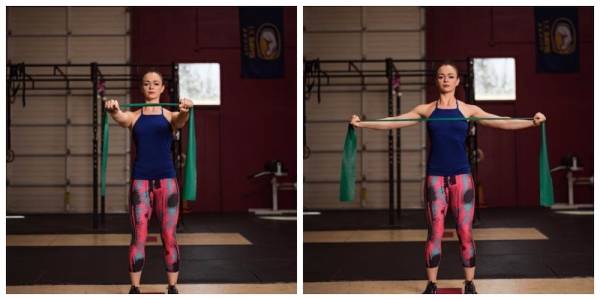
Get In Touch with Your Joints and Muscles: 3. Upper Body Mobility
- 1:00-2:00 -Thoracic foam roll and extensions
We are targeting the mid-to-upper back here so avoid the low back and avoid the neck. Start face up on the ground, hollow out your torso, place the foam roller under your upper back, and use your legs to push yourself forward and backward.
Pause with the foam roller against a tense area (across the shoulder blades is a good one), place the hips down on the ground, and arch back over the foam roller, dropping your arms back over your head. Hold for 10-15 seconds, return to the rolling motion and repeat these extensions in a few more spots on the upper back.
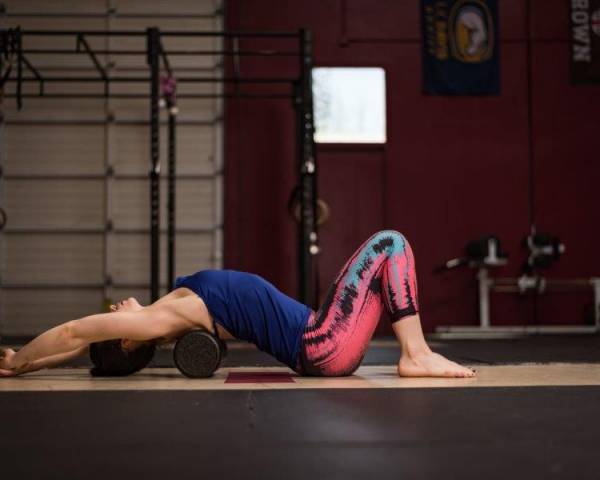
Get In Touch with Your Joints and Muscles: 4. Lower Body Stability
- 1:00 – Lunge hold, per side
Stagger your legs with one foot a healthy distance in front of the other. Lunge down to hover your back knee and drive through your front heel, keeping your front knee over your front ankle. Bend both of your legs and keep your torso upright. Squeeze your glutes and quads.
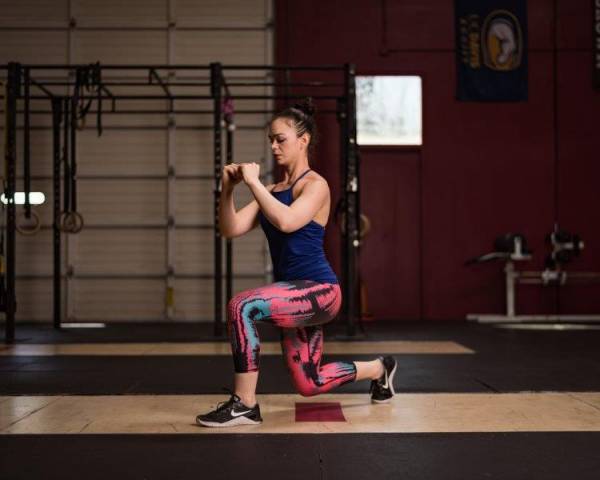
Get In Touch with Your Joints and Muscles: 5. Lower Body Mobility
- 1:00 – Figure 4 glute stretch, per side
Begin by lying on your back with your working leg crossed over the other in a figure 4 shape. Place your hands (or if you need, you can use a band to assist you here) behind the hamstrings of the non-stretching leg, and lean back to pull your legs in toward your chest. Avoid excessive rounding of the back here, try to keep both hips on the floor.
